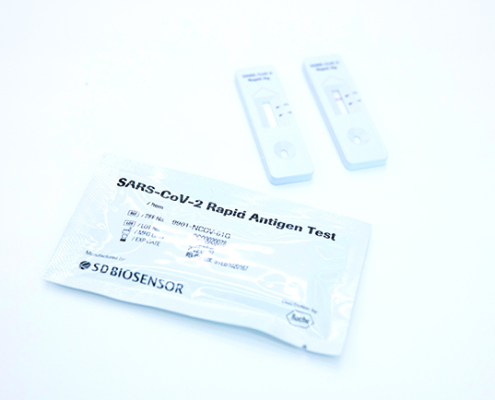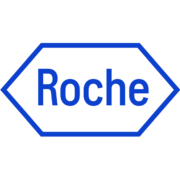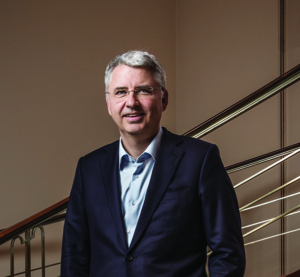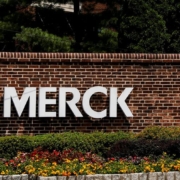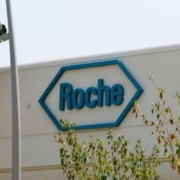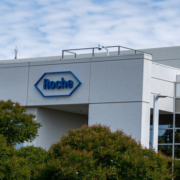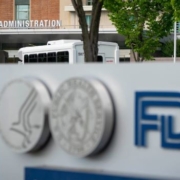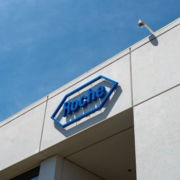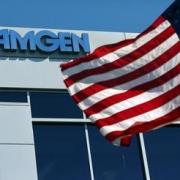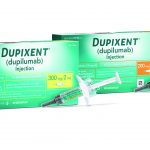Roche 2022: Portfolio renewal
A strong product pipeline and increased group sales confirm that Roche is on the right growth path.
By Andrew Humphreys • [email protected]
CH-4070 Basel, Switzerland
+41 61 688 11 11 • roche.com
| Financial Performance | ||||
| 2021 | 2020 | 1H 2022 | 1H 2021 | |
| Revenue | $68,680 | $63,783 | $35,318 | $33,588 |
| Net income | $16,333 | $16,479 | $10,019 | $8,985 |
| Diluted EPS | $17.72 | $18.07 | $11.53 | $9.90 |
| R&D expense | $14,991 | $13,291 | $7,248 | $7,316 |
|
All sales are in millions of dollars, except EPS, and were translated using the Federal Reserve Board’s average rate of exchange in 2021: SFr 0.9144. |
||||
Best-selling Rx products
All sales are in millions of dollars and were translated using the Federal Reserve Board’s average rate of exchange in 2021: SFr 0.9144.
2021 sales
- Ocrevus $5,528
- Perjeta $4,325
- Actemra/RoActemra $3,895
- Tecentriq $3,625
- Avastin $3,342
- Hemlibra $3,305
- Herceptin $2,946
- Rituxan/MabThera $2,805
- Kadcyla $2,168
- Xolair $2,124
- Ronapreve $1,783
- Alecensa $1,483
- Lucentis $1,480
- Activase, TNKase $1,435
- Esbriet $1,136
- Gazyva/Gazyvaro $741
- Evrysdi $658
- CellCept $647
- Pulmozyme $619
1H 2022 sales
- Ocrevus $3,182
- Perjeta $2,254
- Hemlibra $1,997
- Tecentriq $1,923
- Actemra/RoActemra $1,591
- Herceptin $1,289
- Avastin $1,249
- Rituxan/MabThera $1,190
- Kadcyla $1,175
- Xolair $1,121
- Alecensa $815
- Ronapreve $666
- Lucentis $626
- Activase, TNKase $611
- Evrysdi $547
- Esbriet $500
- Gazyva/Gazyvaro $382
- Phesgo $355
- Pulmozyme $305
- CellCept $295
Outcomes Creativity Index Score: 13
- Manny Awards — N/A
- Cannes Lions — 2
- Clio Health — 3
- Creative Floor Awards — 7
- London International Awards – 1
- MM+M Awards — N/A
- One Show — N/A
Since being founded, Roche has worked to improve the health and lives of countless people across the globe. According to management, Roche’s 125th anniversary year was no exception: During 2021 the company’s more than 100,000 employees and Roche’s partners developed, manufactured, and provided worldwide access to state-of-the-art diagnostics and treatments for serious diseases including COVID-19. “These efforts were guided by the pioneering spirit that has characterized Roche since its founding,” company executives stated.
Roche itself was established under the effect of a pandemic, according to the company. “Fritz Hoffmann had just taken up a position as a merchant in Hamburg in the summer of 1892 when cholera broke out. As a result of this experience, he decided to set up an industrial pharmaceutical company on his return to Basel. His aim was to provide large quantities of effective medicines of uniform quality; this was still a revolutionary concept at the time. During the 126 years since its establishment, Roche has repeatedly found the courage to reinvent itself – guided by scientific progress.”
According to Roche Chairman Dr. Christoph Franz, “The impact of researchers such as Leo Sternbach, a Polish chemist, was enormous: In the 1960s he discovered the benzodiazepines Valium and Librium, which have become indispensable in the treatment of anxiety, insomnia and nervousness. Roche is still actively involved in the field of neuroscience. Ocrevus for the treatment of multiple sclerosis is one of our most sought-after medicinal products. Further milestones in our company’s history include our early adoption of biotechnology at a time when almost nobody believed in it. We used the discovery of monoclonal antibodies to revolutionize cancer therapy. With our PCR technology, we were also pioneers in molecular diagnostics.”
Roche Group CEO Dr. Severin Schwan stated, “Improving people’s lives by delivering medical innovations – that is what Roche has been about for 126 years now. Many of our medicines which were developed decades ago are still greatly benefiting millions of people today. The World Health Organization’s Model List of Essential Medicines includes 32 of our products – a record high.”
Schwan continues, “In the future, too, Roche’s success will be based on medical innovations. Despite all the successes, there is still a great need for better therapies in many areas, such as cancer, dementia and infections, far beyond COVID-19. A need for effective treatments to give people with serious diseases a better life or even cure them, a need for precision diagnostics to find the cause of a disease and treat it at the earliest possible stage. Preventive diagnostics are also gaining increasing significance.”
According to Schwan, “Looking ahead, I am pleased with the continued high demand for our newly launched medicines and diagnostic tests as well as the development of our product pipelines in both divisions.”
Financial & Product performance
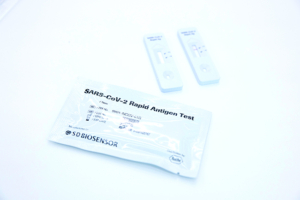
Sales of Roche’s COVID-19-related tests amounted to CHF 3.1 billion ($3.39 billion) during the first six months of 2022, with the SARS-CoV-2 Rapid Antigen test accounting for 63 percent of the total.
Group sales for Roche during first-half 2022 increased 5 percent year-over-year at constant exchange rates (CER) and 5 percent in Swiss francs to CHF 32.3 billion ($35.32 billion). According to Roche, the improvement was mainly driven by the Diagnostics Division, with sales growth of COVID-19-related products and growth in routine testing across all regions. For the Pharmaceuticals Division, sales grew due to the continuing uptake of new medicines, which offset the negative impact from biosimilar competition.
Core operating profit growth of 9 percent was reported for the first six months of 2022. The 9 percent year-over-year improvement reflected the sales growth and additionally the income from the Ultomiris patent settlement.
IFRS net income grew 12 percent (12 percent in Swiss francs), and core earnings per share increased 11 percent compared to first-half 2021. Roche said these increases included positive impacts of 3 percentage points from the Ultomiris patent settlement, net of tax, and 6 percentage points from the share repurchase from Novartis, net of additional financing costs and tax. Roche reported operating free cash flow of CHF 9.78 billion ($10.7 billion), up 21 percent versus first-half 2021, due to the higher cash generation of the business including the Ultomiris patent settlement. Free cash flow amounted to CHF 7.1 billion ($7.76 billion), an increase of 18 percent, due to the growth in the operating free cash flow.
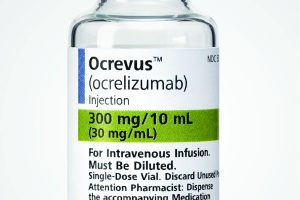
Marketed for treating relapsing forms of multiple sclerosis (RMS) and primary progressive multiple sclerosis (PPMS), Ocrevus continued the medicine’s growth development during first-half 2022 with a year-over-year sales increase of 17 percent to CHF 2.91 billion ($3.18 billion).
Pharmaceuticals Division sales during the 2022 first half grew 3 percent at CER to CHF 22.35 billion ($24.44 billion). According to Roche, growth was aided by continued strong demand for new medicines to treat severe diseases. The improved performance was fueled by growing demand for Hemlibra (emicizumab), Ocrevus (ocrelizumab), Evrysdi (risdiplam), Phesgo (pertuzumab, trastuzumab, and hyaluronidase-zzxf) and Tecentriq (atezolizumab), which combined contributed an additional CHF 1.5 billion (CER, $1.64 billion) of sales. Rituxan/MabThera (rituximab), Herceptin (trastuzumab) and Avastin (bevacizumab) sales declined by a combined CHF 1.0 billion (CER, $1.09 billion), as the impact of biosimilar competition further slowed down.
Diagnostics Division sales for the January–June 2022 period rose 11 percent at CER to nearly CHF 9.95 billion ($10.88 billion), helped by an ongoing strong base business. Total sales of COVID-19-related tests (at CER), notably Roche’s SARS-CoV-2 Rapid Antigen test, amounted to CHF 3.1 billion ($3.39 billion) during first-half 2022. Management said demand for COVID-19 tests was expected to decrease in the second half of 2022. Sales in the division’s base business rose 6 percent at CER, led by the immunodiagnostics business, with cardiac tests being a key contributor.
Upon announcing the first-half 2022 results, Roche said full-year sales were expected to be stable or grow in the low-
single digits (at constant exchange rates). Core earnings per share were targeted to increase in the low- to mid-single digit range (at constant exchange rates), including the accretive effect of the 2021 share repurchase. Management expects to further increase Roche’s dividend in Swiss francs.
Roche anticipates sales of COVID-19 medicines and diagnostics to decrease by CHF 2 billion ($2.19 billion) to around CHF 5 billion ($5.47 billion), and sales losses due to biosimilars in the current year to be roughly CHF 2.5 billion ($2.73 billion). Excluding those effects, Group sales are expected to grow in the high-single digit range.
Product approvals & pipeline updates
Roche’s pharmaceutical clinical pipeline of about 80 new molecular entities encompasses a broad range of diseases, and highly innovative technologies are applied to create and produce the active molecules.
Oncology is the primary area of research and development for Roche. According to management, the company has one of the industry’s broadest and most comprehensive oncology pipelines and portfolios.
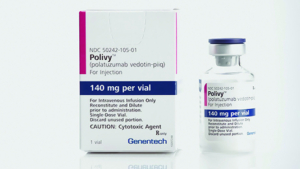
The anti-CD79b antibody-drug conjugate Polivy represents the first new treatment regimen in more than 20 years to significantly improve outcomes in people with previously untreated diffuse large B-cell lymphoma (DLBCL), a fast-growing form of lymphoma.
In the second quarter of 2022, Roche attained various milestones in the challenging area of blood cancers. Roche’s Q2 approvals included the EU marketing clearances of Polivy (first-line treatment for aggressive form of blood cancer), Lunsumio (follicular lymphoma) and Tecentriq (early-stage lung cancer). Also, an EU marketing authorization application was filed for glofitamab (blood cancer).
The European Commission (EC) in May 2022 approved the Polivy (polatuzumab vedotin-piiq) combination therapy for individuals with previously untreated diffuse large B-cell lymphoma (DLBCL). This represents the first therapy in more than 20 years to significantly improve outcomes in this aggressive form of blood cancer.
During August 2022, the FDA accepted Roche’s supplemental Biologics License Application (sBLA) for Polivy in combination with Rituxan plus cyclophosphamide, doxorubicin and prednisone (R-CHP) as a treatment for people with previously untreated DLBCL. The U.S. regulatory agency is expected to make an approval decision by April 2, 2023. Polivy represents the first new treatment regimen in more than 20 years to significantly improve outcomes in people with DLBCL, a fast-growing form of lymphoma.
Polivy represents a first-in-class anti-CD79b antibody-drug conjugate (ADC). The CD79b protein is expressed specifically in the majority of B-cells, an immune cell impacted in some forms of non-Hodgkin lymphoma (NHL), making Polivy a promising target for the development of new medicines.
Various combination trials with Polivy and Roche’s CD20xCD3 bispecifics in diffuse large B-cell lymphoma are under way. Theses studies include testing combinations of Polivy with Roche’s CD20xCD3 T-cell engaging bispecific antibodies Lunsumio (mosunetuzumab) and glofitamab, and with Rituxan in combination with gemcitabine and oxaliplatin in the Phase III POLARGO trial.
The EC in June approved the first-in-class bispecific antibody Lunsumio for relapsed or refractory follicular lymphoma (FL). Soon after, the FDA granted priority review for this innovative medicine. Lunsumio is a new type of immunotherapy that is a chemotherapy-free, fixed-duration treatment option that could improve outcomes for people who have relapsed or are refractory to multiple prior treatments.
During July 2022, the FDA granted Priority Review to Lunsumio for people with relapsed or refractory follicular lymphoma upon accepting Roche’s Biologics License Application (BLA). The potential first-in-class CD20xCD3 T-cell engaging bispecific antibody is intended for treating adults with relapsed or refractory (R/R) FL who have received at least two prior systemic therapies. An FDA decision regarding the approval of this novel cancer immunotherapy for this indication is anticipated by December 29, 2022.
A first-in-class CD20xCD3 T-cell engaging bispecific antibody, Lunsumio is designed to target CD20 on the surface of B-cells and CD3 on the surface of T-cells. This dual targeting activates and redirects a patient’s existing T-cells to engage and eliminate target B-cells by releasing cytotoxic proteins into the B-cells, according to Roche. A robust clinical development program is under way, testing the molecule as a monotherapy and in combination with other medicines, for treating people with B-cell non-Hodgkin lymphomas, including follicular lymphoma, diffuse large B-cell lymphoma, and other blood cancers.
Tecentriq during June was cleared for marketing by the EC for early-stage non-small cell lung cancer (eNSCLC). Tecentriq is the first cancer immunotherapy available for the adjuvant treatment of certain people with eNSCLC in Europe. According to Roche, half of all people with eNSCLC develop recurrence after surgery, which in some cases is no longer curable. Treating this cancer at an earlier stage provides the best chance to prevent recurrence.
In August, Roche reported that the subcutaneous formulation of Tecentriq showed positive Phase III results. The IMscin001 trial demonstrated non-inferior levels of the cancer immunotherapy Tecentriq in the blood, when injected subcutaneously, versus intravenous infusion, in people with advanced NSCLC. Administered under the skin, the subcutaneous form reduces time spent receiving treatment to just minutes, versus up to an hour for IV infusion.
The monoclonal antibody Tecentriq is designed to bind with a protein called programmed death ligand-1 (PD-L1), which is expressed on tumor cells and tumor-infiltrating immune cells, blocking its interactions with PD-1 and B7.1 receptors. The investigational subcutaneous form joins together Tecentriq with Halozyme Therapeutics’ Enhanze drug delivery technology.
The intravenous version of Tecentriq is approved for some of the most aggressive and difficult-to-treat types of cancer. IV Tecentriq was the first cancer immunotherapy cleared for approval for treating a certain form of early-stage NSCLC, small cell lung cancer (SCLC) and hepatocellular carcinoma (HCC). IV Tecentriq is additionally approved in various countries, either alone or in combination with targeted therapies and/or chemotherapies, for different types of metastatic NSCLC, certain forms of metastatic urothelial cancer, PD-L1-positive metastatic triple-negative breast cancer. and BRAF V600 mutation-positive advanced melanoma.
The potential first-in-class bispecific antibody glofitamab may improve the lives of people with the aggressive blood cancer DLBCL. Roche submitted glofitamab for approval to the European Medicines Agency (EMA).
Data presented for the first time at ASCO and EHA 2022 demonstrate glofitamab induces high and durable complete response rates in people with heavily pre-treated DLBCL. Roche said glofitamab has the potential to offer a readily available, fixed-duration CD20xCD3 bispecific antibody treatment approach for people with aggressive lymphoma.
Glofitamab is a member of the company’s industry-leading CD20xCD3 bispecific antibody development program, which aims to address the diverse needs and preferences of people with blood cancers. Roche is evaluating the molecule as a monotherapy and in combination with other medicines, for treating B-cell non-Hodgkin lymphomas, including DLBCL and mantle cell lymphoma, and other blood cancers.
Glofitamab is based on a novel structural format known as ‘2:1’. Glofitamab is engineered to have two ‘Fab’ regions that bind to CD20, and one ‘Fab’ region that binds to CD3. As a result, this dual targeting activates and redirects a patient’s existing T-cells to engage and eliminate target B-cells by releasing cytotoxic proteins into the B-cells.
Roche reported during May 2022 initial results from the first interim analysis of the SKYSCRAPER-01 trial in PD-L1-high metastatic NSCLC. Tiragolumab in combination with Tecentriq did not meet the study’s co-primary endpoint of progression-free survival. The clinical trial will continue for the co-primary endpoint of overall survival to mature, which is a decisive factor in this setting, Roche said. Tiragolumab continues to be assessed in NSCLC and other cancer types via additional Phase III studies.
The novel immune checkpoint inhibitor tiragolumab has an intact Fc region. Research shows tiragolumab selectively binds to TIGIT, a novel inhibitory immune checkpoint, which suppresses the immune response to cancer. Tiragolumab is believed to work as an immune amplifier with other cancer immunotherapies such as Tecentriq.
Roche is developing the oncology drug giredestrant, an oral selective estrogen receptor degrader (SERD). A Phase II trial of giredestrant met the study’s primary endpoint in the most frequently diagnosed type of breast cancer, as reported by Roche in December 2021. The drug candidate demonstrated statistically superior anti-proliferative activity versus standard-of-care treatment (anastrozole) in neoadjuvant estrogen receptor (ER)-positive, HER2-negative breast cancer.
As giredestrant continues to show a tolerable safety profile, Roche advanced the product into the Phase III lidERA Breast Cancer trial for the adjuvant treatment of ER-positive, HER2-negative breast cancer, as part of a comprehensive clinical development program. Giredestrant has received U.S. Fast Track Designation (FTD) as a second-line and third-line treatment for ER-positive, HER2-negative, metastatic breast cancer.
The potent, next-generation investigational selective estrogen receptor (SERD) giredestrant has best-in-class potential, according to Roche. Administered orally, giredestrant delivers an encouraging clinical efficacy and safety profile and has demonstrated superior pre-clinical potency over other SERDs in development.
Eight-year data from the APHINITY trial demonstrated Roche’s Perjeta-based regimen continues to reduce the risk of disease returning for people with HER2-positive early breast cancer. Results at 8.4 years median follow-up (101 months) demonstrated the continued benefit of the combination of Perjeta (pertuzumab), Herceptin (trastuzumab) and chemotherapy (the Perjeta-based regimen), compared to Herceptin, chemo and placebo, when administered as post-surgery (adjuvant) intravenous (IV) treatment for people with lymph node (LN)-positive, HER2-positive early breast cancer, who are at high risk of recurrence. Roche said the greatest benefit continued to be seen in people who are at a high risk of recurrence (those with lymph node-positive disease).
Perjeta targets the HER2 receptor, a protein located on the outside of many normal cells and in high quantities on the outside of cancer cells in HER2-positive cancers. The medicine is designed specifically to prevent the HER2 receptor from pairing (or ‘dimerizing’) with other HER receptors (EGFR/HER1, HER3 and HER4) on cell surfaces, a process that is believed to play a role in tumor growth and survival. Binding of Perjeta to HER2 may additionally signal the body’s immune system to destroy the cancer cells. The mechanisms of action of Perjeta and Herceptin are believed to complement each other, as each bind to the HER2 receptor, but to different locations. The Perjeta-Herceptin combo is believed to provide a more comprehensive, dual blockade of HER signaling pathways, thus preventing tumor cell growth and survival.
Neuroscience represents another major focus of R&D at Roche. Management says the company’s goal is to pursue groundbreaking science to develop new treatments that help improve the lives of people with chronic and potentially devastating diseases.
Roche is investigating more than one dozen products for neurological disorders, including multiple sclerosis, Alzheimer’s disease, Huntington’s disease, Parkinson’s disease, Duchenne muscular dystrophy, and autism spectrum disorder. “Together with our partners, we are committed to pushing the boundaries of scientific understanding to solve some of the most difficult challenges in neuroscience today,” according to Roche.
One of the lead stories of Roche’s product performance during 2022 was the U.S. approval of Evrysdi in May for babies under 2 months of age with spinal muscular atrophy (SMA). Roche said this approval is particularly significant, as early treatment of SMA – before symptoms start to appear – can help babies achieve motor milestones. The marketing clearance is based on interim RAINBOWFISH data demonstrating pre-symptomatic babies treated with Evrysdi for at least one year were able to sit, stand, and walk. The drug’s prescribing information was updated with FIREFISH data demonstrating the majority of symptomatic babies treated with Evrysdi for at least two years could sit for at least five seconds.
Also, the company announced new three-year data from the FIREFISH study, reinforcing the long-term efficacy and safety of Evrysdi in infants with symptomatic type 1 SMA.
Roche announced clinical trial results of crenezumab in June 2022. The study assessed the potential of crenezumab to slow or prevent Alzheimer’s disease in cognitively unimpaired people who carry a specific genetic mutation that causes early-onset Alzheimer’s disease. While the treatment did not show a statistically significant clinical benefit, Roche is “confident that the rich data collected will enhance the broader scientific community’s knowledge of Alzheimer’s disease as well as support future research efforts in the field.”
Data presented for Ocrevus during April 2022 demonstrated benefit in disability progression and cognitive decline in secondary progressive and primary progressive multiple sclerosis. The data showed 75 percent of patients with secondary progressive multiple sclerosis (SPMS) and primary progressive MS (PPMS) achieved no evidence of progression (NEP) in a one-year interim analysis of the CONSONANCE study. Also, 70 percent of patients with SPMS and PPMS showed stable or improved cognition after one year of Ocrevus treatment in CONSONANCE. A separate analysis on treatment disparities demonstrated fewer Black and Hispanic patients with MS initiate high-efficacy treatments within two years of diagnosis The clinical data support the body of evidence for Ocrevus more than 450,000 patient years and over 225,000 patients treated worldwide.
Ocrevus is the first therapy approved for both RMS (including RRMS, active SPMS and CIS in the United States) and PPMS, with six-month dosing. The humanized monoclonal antibody is designed to target CD20-positive B cells, a specific form of immune cell believed to be a key contributor to myelin (nerve cell insulation and support) and axonal (nerve cell) damage. This nerve cell damage can result in disability in people with MS.
New data reported by Roche in July 2022 from the Phase III HAVEN 6 trial reinforce the favorable safety and efficacy profile of Hemlibra in people with moderate or mild hemophilia A. According to the study results, Hemlibra continues to show clinically meaningful bleed control, with 66.7 percent of participants with moderate or mild hemophilia A experiencing zero treated bleeds at 55.6 weeks median follow-up. The data additionally reinforce Hemlibra’s favorable safety profile, with no new safety signals observed, according to Roche.
Hemlibra is approved for treating people of all ages with hemophilia A with factor VIII inhibitors in more than 110 countries and for people of all ages without factor VIII inhibitors in 95-plus countries. The bispecific factor IXa- and factor X-directed antibody is designed to bring together factor IXa and factor X, proteins involved in the natural coagulation cascade, and restore the blood-clotting process for individuals with hemophilia A.
The prophylactic (preventative) treatment Hemlibra was created by Chugai Pharmaceutical and is being jointly developed worldwide by Chugai, Roche and Genentech. The product is marketed in the United States by the Roche subsidiary Genentech as Hemlibra (emicizumab-kxwh), with kxwh as the suffix designated in accordance with Nonproprietary Naming of Biological Products Guidance for Industry issued by the FDA.
During September 2022, the EC approved Vabysmo (faricimab) as a treatment for neovascular or ‘wet’ age-related macular degeneration (nAMD) and visual impairment due to diabetic macular edema (DME). Roche said these retinal conditions are two of the leading causes of vision loss globally, affecting more than 40 million people. Vabysmo is approved in the European Union and nine other countries, including the United States, Japan, and the UK, with filings to other regulatory authorities under way.
Vabysmo is the only injectable eye medicine available in Europe with Phase III trials supporting treatment at intervals of up to four months for people living with nAMD and DME. The bispecific antibody is uniquely engineered to target and inhibit two disease pathways, linked to various vision-threatening retinal conditions, by neutralizing angiopoietin-2 (Ang-2) and vascular endothelial growth factor-A (VEGF-A), to restore vascular stability.
During February 2022, two-year clincial data were presented for Vabysmo and Susvimo (previously called Port Delivery System with ranibizumab) reinforcing the potential to maintain vision with fewer treatments for people with DME and nAMD. These longer-term results from the Vabysmo YOSEMITE and RHINE clinical trials in DME and the Susvimo Archway study in nAMD further reinforce the potential to allow for longer time between treatments and fewer eye injections for people with these conditions, while still achieving and maintaining vision gains evident with previous standard-of-care injections.
The refillable eye implant Susvimo is surgically inserted into the eye during a one-time, outpatient procedure. The implant continuously delivers a customized formulation of ranibizumab over time. According to Roche, Susvimo is indicated for intravitreal use via the eye implant only. The vascular endothelial growth factor (VEGF) inhibitor ranibizumab is designed to bind to and inhibit VEGF-A, a protein that has been demonstrated to play a critical role in the formation of new blood vessels and the leakiness of the vessels.
Roche says Susvimo is different from the ranibizumab intravitreal injection, a blockbuster medicine marketed by the company as Lucentis (ranibizumab injection), which is approved for treating nAMD and other retinal diseases. Lucentis was initially approved for nAMD by the FDA during 2006.
Roche’s Xofluza (baloxavir marboxil) won marketing clearance during August 2022 as the only single-dose oral medicine for treating influenza to be approved in the United States for children as young as 5 years of age. The FDA additionally approved Xofluza to prevent influenza in children aged 5 years and older following contact with an infected person.
Xofluza was previously approved by the FDA to treat influenza in people 12 years of age and older who have had influenza symptoms for no more than 48 hours and who are otherwise healthy or at high risk of developing influenza-related complications. Available as a one-dose, single-tablet, the product is also approved for the prevention of influenza in people 12 years of age and older following contact with someone with influenza (known as post-exposure prophylaxis).
COVID-19 therapeutics & Tests
Roche is deeply dedicated to supporting the worldwide response to put an end to the COVID-19 pandemic, management says. Around the globe, the company is “working with urgency, passion and purpose each and every day to deliver high-quality tests that are essential for healthcare systems and patients alike.”
Roche was issued FDA Emergency Use Authorization (EUA) during June 2022 for the company’s cobas SARS-CoV-2 Duo, the first PCR test to detect the COVID-19 virus and simultaneously measure the viral load in an individual. The test assists healthcare providers with contact tracing, patient triage, therapy and monitoring.
Roche launched a new diagnostic test for the better understanding of immune response to SARS-CoV-2 during August 2022. According to Roche, Elecsys IGRA SARS-CoV-2 test supports the better understanding of immune response to SARS-CoV-2 infection or vaccination. The test detects T-cell response, which may play a significant role in determining if immune protection has been achieved. The new diagnostic test may provide clinical care guidance, especially for immunocompromised and high-risk patient groups.
The FDA granted priority review during April 2022 to Actemra/RoActemra (tocilizumab) for treating COVID-19 in hospitalized adults. If cleared for marketing, Actemra/RoActemra would be the first U.S. FDA-approved immunomodulator for treating COVID-19 in hospitalized patients.
Emergency Use Authorization from the FDA was received in June 2021 for Actemra/RoActemra, which is approved for marketing in at least 16 countries for defined patients hospitalized with severe or critical COVID-19. The World Health Organization (WHO) during February 2022 prequalified Actemra/RoActemra for patients with severe or critical COVID-19, supporting access to care in low-income and middle-income countries.
Beyond COVID-19, Actemra/RoActemra was the first humanized interleukin-6 (IL-6) receptor antagonist approved for treating adults with moderately to severely active rheumatoid arthritis (RA) who have used one or more disease-modifying antirheumatic drugs (DMARDs), such as methotrexate (MTX), that did not provide enough relief.
Non-COVID Diagnostic launches & updates
For Roche’s Diagnostics business, among the 2022 highlights have been the launches of innovative platforms and systems for tissue-based cancer diagnostics, of HPV self-sampling solution and monkeypox virus test kits. According to Roche, diagnostic tools are critical for responding to and ultimately controlling emerging public health challenges.
Roche and the company’s subsidiary within the Diagnostics division, TIB Molbiol, in May 2022 swiftly developed three unique PCR LightMix Modular Virus test kits that detect the monkeypox virus and aid in tracking its epidemiologic spread. Roche executives said use of these new research test kits evaluate the spread of the virus and can help monitor the potential impact of therapeutics, vaccines, and public health interventions.
During March 2022, Roche and TIB Molbiol announced available testing solutions that can identify the SARS-CoV-2 B.1.1.529 variant and differentiate between the Omicron subvariants BA.1, BA.1.1, BA.2, BA.2.2, BA.3 and Delta. According to Roche, use of these tests evaluate the spread of circulating variants and can help monitor the potential impact of therapeutics, vaccines and public health interventions. Every Roche SARS-Cov-2 test correctly identifies the virus including these new subvariants, the company said.
Roche introduced during August 2022 a next-generation digital PCR system, a powerful new diagnostics platform in the fight against cancer and other diseases. The Digital LightCycler System helps clinical researchers better understand the nature of a patient’s cancer, genetic disease or infection.
According to Roche, the new system has the potential to find and quantify ultra-rare, hard-to-detect mutations, resulting in early diagnosis and treatment strategies. The system is designed for laboratories performing highly sensitive and precise DNA and RNA analysis in areas such as oncology and infectious diseases.
More than 600,000 women around the globe are diagnosed with cervical cancer annually, and over half die from the disease. According to Roche, cervical cancer is caused by infection with the human papillomavirus (HPV) and is preventable with timely diagnosis. During June 2022, the company introduced a self-sampling solution for the cobas HPV test in countries accepting the CE mark. Enabling women to self-collect their own specimens for HPV testing is a critical step in the fight against cervical cancer, Roche said.
Additionally in June, Roche announced the CE launch of the Ventana DP 600. The high-capacity slide scanner produces high-resolution, digital images of stained tissue samples that aid in the diagnosis of cancer.
Ventana DP 600 also enables better and more personalized healthcare. In combination with Roche’s AI image analysis algorithms, this solution can help ensure that each patient receives the most effective treatment plan possible.
Roche also launched the advanced tissue staining platform BenchMark Ultra Plus during June. This system allows pathologists to provide quick and accurate results that help inform patient treatment options.
The company introduced during July 2022 Elecsys HCV Duo, the first commercially available diagnostic test for the simultaneous and independent determination of the hepatitis C virus (HCV) antigen and antibody status. About 60 million people around the globe live with chronic hepatitis C (HCV) infection, but only one in five is aware of it.
At the beginning of 2022, Roche introduced the cobas pulse system, an industry-first professional blood glucose management solution with mobile digital health capabilities to improve patient care. The handheld blood glucose management device is designed around the specific needs of healthcare professionals working in various care settings. Roche said this is the first diagnostic solution at the point of care to serve as a digital platform connecting developers of digital health software and applications to HCPs. The new system simplifies workflows and equips HCPs with valuable clinical insights to deliver better patient care.
Also during January, Roche launched cobas infinity edge, a new open digital ecosystem for point of care (POC) professionals, driving improved patient outcomes and operational efficiencies in healthcare.
The company’s new cloud-based platform connects patient test results, medical records and third-party applications, enabling professionals to monitor patients’ health, adjust treatment protocols, and make quick data-driven patient care decisions anytime, anywhere within and across clinical settings.
The new digital ecosystem breaks down common information silos for POC professionals, cutting down costs and administrative burdens by connecting information securely and compliantly across devices, providers, and locations. Cobas infinity edge is designed as an open platform, enabling HCPs to easily access and adopt third-party innovators’ new digital tools and medically relevant applications via the company’s digital marketplace.
Partnerships
Roche during May 2022 renewed the company’s commitment to the World Federation of Hemophilia (WFH) Humanitarian Aid Program until the end of 2028. Roche will continue to provide the prophylactic medicine Hemlibra to treat people with hemophilia A in developing countries.
Additionally during May, Roche entered into a partnership with the Global Fund to support low-income and middle-income countries in strengthening critical diagnostic infrastructure. Roche management said this new partnership aims to help millions of previously undiagnosed people with tuberculosis and HIV get diagnosed and eventually treated.

